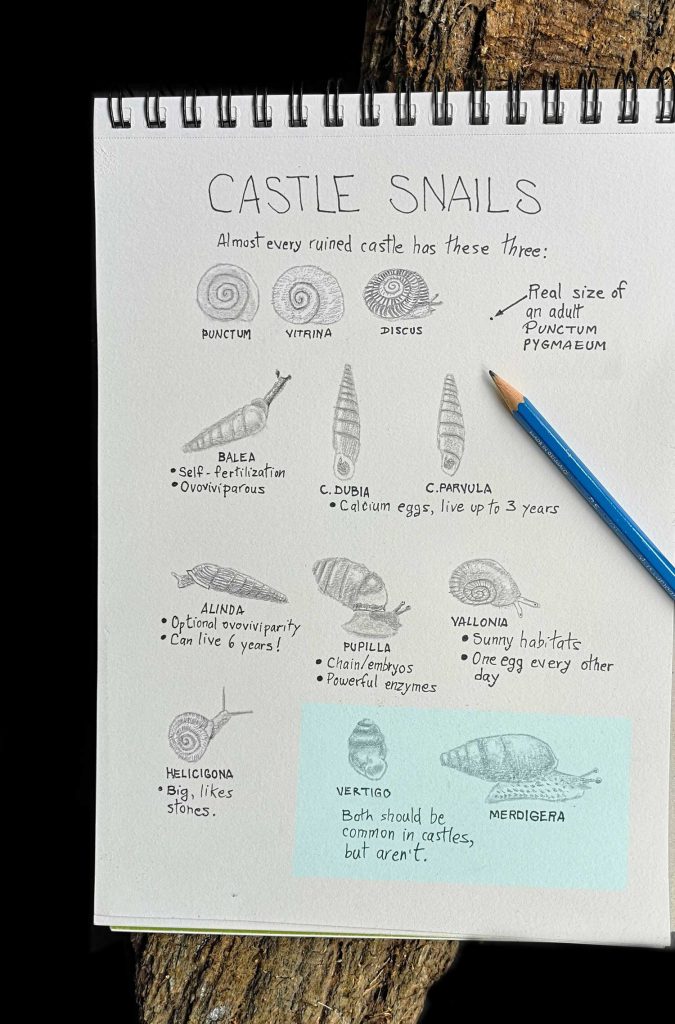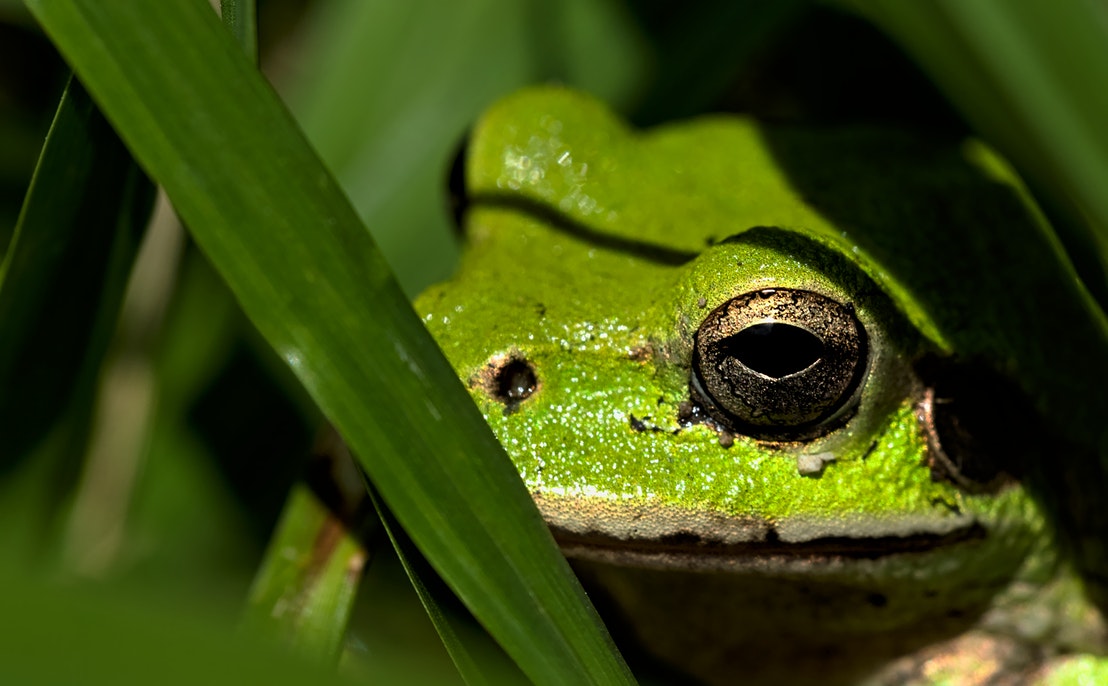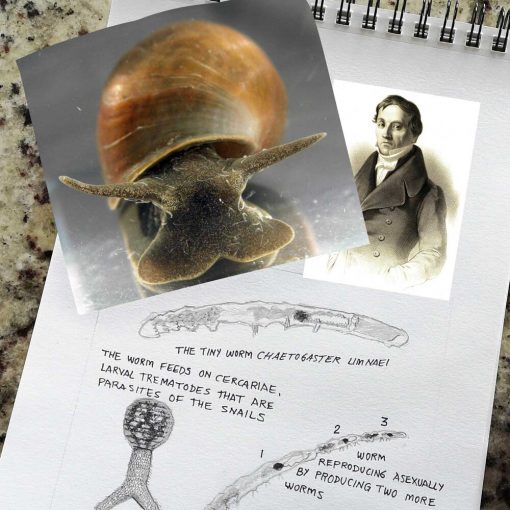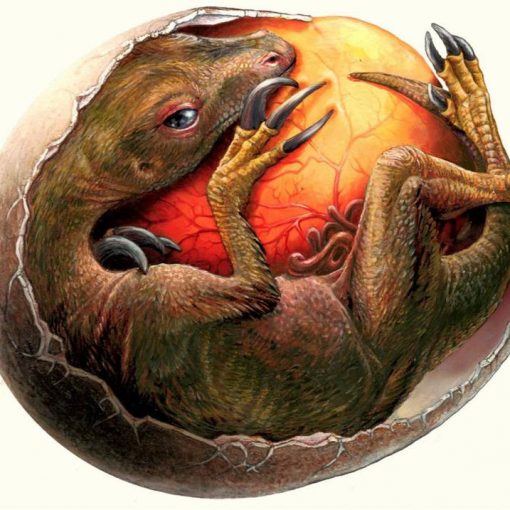Author: Julián Monge Nájera, Ecologist and Photographer
In the Middle Ages, vassals cut down the vast forests than once ruled Europe, and built stone castles, meant to be inhabited by ladies and defended by knights in armor; these people would inspire the legends and fairy tales that still entertain our childhood. If there was no hill, the castle was built on the plains, but it was surrounded by moats and drawbridges. Centuries passed and cannons rendered the stone walls useless, so most of the castles were abandoned and slowly they have been falling apart, filling the soil with calcium carbonate and cracked stones, the ideal habitat for many land snails. When biologists looked closely at the species in these ruins, the surprise was not only what they found, but also what they did not find.

Ruins of a castle near Cork, Ireland. Source: Wikicommons
In a spectacular work in which over a decade she methodically collected snails from 123 European castles, Czech malacologist Lucia Jurickova found something unexpected and perhaps encouraging: eight species, some of them endangered, are much more common in castles. than in nature¹.
If there were tours to see snails in ruined castles, tourists could almost be guaranteed to see three species regardless of the castle: Punctum pygmaeum, Vitrina pellucida, and Discus rotundatus.
Punctum pygmaeum is, as its name suggests, tiny, measuring at most 1.5 mm in diameter when fully grown; it is found in much of Eurasia, in mosses, lichens, fallen vegetation, and stones, even if there is little calcium. It is hermaphroditic but has cross-mating, and it lays from 1 to 16 proportionally huge eggs.
The semi-slug Vitrina pellucida lives in forests as well as in meadows and gardens, where it eats decomposed vegetation, but it also scrapes liverworts, carrion, and feces. Their eggs are soft and their enemies include hedgehogs and the parasitic nematode Elaphostrongylus. It is a semi-slug because it is in the process of reducing its shell, in fact, it no longer fits in it.
The snail Discus rotundatus lives in fallen logs, litter, and even gardens, sometimes in groups, and is unaffected by low calcium soils; it lays 20 to 50 eggs in the litter and is moderately long-lived (3 years).
There is a second group, species that are more abundant in castles than in nature, and the first species in this group is Balea perversa, relatively well studied, although extinct in some parts of Europe. It lives in rocky substrates; especially if they have rough textures and are heated by the sun; where it feeds on bacteria, algae, and fungi. Like many other land snails, it produces eggs that need a couple of weeks to hatch, and the snails become adults within a few months. It is an unusual species because it tends to self-fertilize and keep the eggs inside the body until the babies are born.
The second species is Clausilia dubia, remarkable for having eggs with a calcified shell (a luxury among mollusks) and because despite its small size its lifespan exceeds 3 years. It is found in moist microhabitats on the ground, trees, and rock faces. Another species that practically has the same natural history is Clausilia parvula, but experts do not yet agree on whether it is a valid species or is the same Clausilia dubia.
The species Alinda biplicata is relatively large (2 cm long), long-lived (6 years) and produces up to 50 babies per year; it can lay eggs or retain them in the body until they hatch.
Next on the list is Pupilla muscorum, which is found in dunes, stones, and leaf litter; its reproductive tract is like a production line with a row of embryos in sequential stages of development, something spectacular and atypical among mollusks. It is also extraordinary for having the digestive enzymes needed to digest live vegetation (many snails can only digest decomposing vegetation).

In my sketchbook: three snails that are in practically every castles (top row); six species that are more abundant in castles than in nature, and, below in blue, the two species that should be common in castles but, for unknown reasons, are not. All this shows how much we still have to do in this area of malacology.
The tiny Vallonia costata is almost invisible and inhabits grasslands, rocky areas, and dunes. It lives for several years and every 1-4 days it lays an egg, which gives it enormous power of reproduction, which, together with its ability to live in sunny and dry places, explains why it is found throughout the Mediterranean basin.
Finally, a snail with a nice Latin name that means «stone killer», Helicigona lapicida, scrapes cyanobacteria and lichens from stones, even from gravestones in cemeteries. It is large (2 cm in diameter) and in an experiment in which specimens were marked, it was found that in one year the majority did not move more than 10 meters from the original location.
What do these species, so successful in castles, have in common?
That question has yet to be answered. Furthermore, there are two species that seem ideal to abound in castles but are not: Vertigo pygmaea and Merdigera obscura¹.
As its name suggests, Vertigo pygmaea is small and is found in moist and dry habitats. It is relatively abundant and, given its ecological needs, one might expect it to be common in castles, but it is only found in one out of ten castles, and as a rule, in small numbers. The other, Merdigera obscura, is seen with some frequency on logs, stones, and litter, even on walls, but it is also rare in castles. Why?
Even with her in-depth knowledge of European snails, Dr. Jurickova has yet to find the answer¹.
*Edited by Zaidett Barrientos, Katherine Bonilla y Carolina Seas.
Originally published in Blog Biología Tropical: 25 august 2020
REFERENCES
¹ Juřičková, L. (2005). Molluscs (Mollusca) of castles as an ecological phenomenon (Czech Republic). Historie, 102, 103; 100-148.





250 ideas sobre “Why did snails replace the ladies and knights of medieval castles?”
Excellent article! We will be linking to this particularly great article on our site. Keep up the good writing.
I have learned newer and more effective things from a blog post. Yet another thing to I have recognized is that in many instances, FSBO sellers are going to reject anyone. Remember, they will prefer to never use your services. But if anyone maintain a comfortable, professional relationship, offering help and staying in contact for about four to five weeks, you will usually be capable to win a conversation. From there, a house listing follows. Many thanks
As I website possessor I believe the content material here is rattling fantastic , appreciate it for your efforts. You should keep it up forever! Best of luck.
Heya! I’m at work surfing around your blog from my new iphone! Just wanted to say I love reading your blog and look forward to all your posts! Carry on the fantastic work!
I have been exploring for a little bit for any high-quality articles or weblog posts on this kind of space . Exploring in Yahoo I eventually stumbled upon this web site. Studying this info So i am happy to express that I’ve an incredibly good uncanny feeling I came upon just what I needed. I most without a doubt will make sure to don?t omit this website and give it a look on a continuing basis.
Excellent blog right here! Also your web site lots up very fast! What web host are you the use of? Can I get your affiliate hyperlink for your host? I desire my site loaded up as quickly as yours lol
Good day! I know this is kinda off topic but I’d figured I’d ask. Would you be interested in trading links or maybe guest writing a blog post or vice-versa? My website discusses a lot of the same topics as yours and I think we could greatly benefit from each other. If you happen to be interested feel free to shoot me an e-mail. I look forward to hearing from you! Terrific blog by the way!
Thanks for your posting on this weblog. From my personal experience, many times softening upwards a photograph may well provide the photo shooter with a chunk of an inspired flare. Sometimes however, that soft clouds isn’t exactly what you had as the primary goal and can quite often spoil a normally good photo, especially if you anticipate enlarging it.
It?s actually a nice and useful piece of information. I?m glad that you shared this helpful info with us. Please keep us informed like this. Thanks for sharing.
Oh my goodness! an amazing article dude. Thank you However I am experiencing situation with ur rss . Don?t know why Unable to subscribe to it. Is there anyone getting an identical rss drawback? Anyone who knows kindly respond. Thnkx
Thanks, I’ve been searching for information about this subject for ages and yours is the best I have found so far.
excellent points altogether, you just won a new reader. What could you recommend about your publish that you made a few days in the past? Any positive?
There are some interesting closing dates on this article but I don?t know if I see all of them center to heart. There is some validity but I’ll take hold opinion until I look into it further. Good article , thanks and we wish extra! Added to FeedBurner as well
I would like to thnkx for the efforts you have put in writing this website. I’m hoping the same high-grade blog post from you in the upcoming also. Actually your creative writing skills has inspired me to get my own blog now. Really the blogging is spreading its wings quickly. Your write up is a good example of it.
Top Stage Hypnotist for hire Kristian von Sponneck performs private stage hypnosis shows anywhere in the UK, Europe or worldwide. Hire hime for your next event!
Hello There. I found your blog using msn. This is an extremely well written article. I?ll be sure to bookmark it and come back to read more of your useful information. Thanks for the post. I?ll certainly comeback.
Thanks for your helpful post. Over time, I have come to be able to understand that the actual symptoms of mesothelioma are caused by your build up associated fluid involving the lining in the lung and the chest muscles cavity. The disease may start within the chest place and multiply to other parts of the body. Other symptoms of pleural mesothelioma cancer include fat reduction, severe breathing in trouble, throwing up, difficulty taking in food, and swelling of the neck and face areas. It ought to be noted that some people living with the disease tend not to experience just about any serious indicators at all.
Hello there, You’ve done a fantastic job. I?ll definitely digg it and in my opinion recommend to my friends. I am confident they’ll be benefited from this website.
An outstanding share! I’ve just forwarded this onto a colleague who had been doing a little homework on this. And he in fact ordered me lunch because I stumbled upon it for him… lol. So let me reword this…. Thank YOU for the meal!! But yeah, thanks for spending the time to talk about this matter here on your blog.
I have observed that car insurance firms know the automobiles which are at risk from accidents and other risks. Additionally they know what type of cars are susceptible to higher risk plus the higher risk they have the higher the premium rate. Understanding the basic basics associated with car insurance just might help you choose the right sort of insurance policy which will take care of the needs you have in case you happen to be involved in any accident. Many thanks for sharing the actual ideas on your blog.
Hey! This is my first visit to your blog! We are a group of volunteers and starting a new initiative in a community in the same niche. Your blog provided us beneficial information to work on. You have done a wonderful job!
Thanks alot : ) for your post. I’d prefer to comment that the tariff of car insurance varies widely from one insurance policy to another, since there are so many different facets which bring about the overall cost. Such as, the model and make of the vehicle will have a significant bearing on the price tag. A reliable older family motor vehicle will have a lower priced premium when compared to a flashy sports car.
Hi, Neat post. There is a problem with your web site in internet explorer, would check this? IE still is the market leader and a huge portion of people will miss your fantastic writing because of this problem.
I think that is among the so much vital information for me. And i’m happy studying your article. However wanna commentary on few general issues, The web site style is perfect, the articles is in point of fact excellent : D. Good process, cheers
wonderful submit, very informative. I wonder why the other experts of this sector don’t realize this. You must proceed your writing. I’m sure, you have a huge readers’ base already!
I am often to running a blog and i actually appreciate your content. The article has really peaks my interest. I am going to bookmark your site and preserve checking for brand new information.
Hello there, just became alert to your blog through Google, and located that it’s really informative. I am going to watch out for brussels. I?ll appreciate for those who continue this in future. Lots of other people might be benefited from your writing. Cheers!
With havin so much written content do you ever run into any problems of plagorism or copyright violation? My site has a lot of unique content I’ve either written myself or outsourced but it seems a lot of it is popping it up all over the internet without my agreement. Do you know any techniques to help reduce content from being ripped off? I’d really appreciate it.
Pretty nice post. I just stumbled upon your blog and wanted to say that I’ve truly enjoyed surfing around your blog posts. After all I?ll be subscribing to your feed and I hope you write again soon!
Hey, I think your website might be having browser compatibility issues. When I look at your website in Safari, it looks fine but when opening in Internet Explorer, it has some overlapping. I just wanted to give you a quick heads up! Other then that, excellent blog!
I do love the manner in which you have presented this specific matter plus it does provide us a lot of fodder for thought. Nevertheless, because of just what I have witnessed, I basically hope as the commentary pack on that individuals stay on issue and in no way get started upon a soap box regarding some other news du jour. All the same, thank you for this exceptional point and although I do not really go along with this in totality, I regard your standpoint.
Youre so cool! I dont suppose Ive read anything like this before. So good to search out any individual with some unique ideas on this subject. realy thanks for starting this up. this website is one thing that is needed on the web, somebody with just a little originality. helpful job for bringing something new to the internet!
Thanks for the advice on credit repair on your blog. Some tips i would advice people should be to give up this mentality they can buy currently and fork out later. Like a society we tend to repeat this for many things. This includes holidays, furniture, as well as items we would like. However, you have to separate your current wants out of the needs. While you’re working to improve your credit rating score you really have to make some sacrifices. For example you are able to shop online to save money or you can look at second hand merchants instead of highly-priced department stores to get clothing.
Viagra
Porn
Porn site
Viagra
Sex
Sex
Pornstar
Pornstar
Pornstar
Scam
Pornstar
Scam
Porn site
Sex
Porn
Porn site
Sex
Porn
Pornstar
Pornstar
Porn
Scam
Sex
Viagra
Porn site
Viagra
Buy Drugs
Viagra
Pornstar
Porn
Buy Drugs
Viagra
Porn
Sex
Viagra
Sex
Sex
Pornstar
Porn
Sex
Porn site
Scam
Scam
Pornstar
Buy Drugs
Buy Drugs
Porn site
Buy Drugs
Pornstar
Scam
Viagra
Porn
Buy Drugs
Buy Drugs
Scam
Viagra
Viagra
Viagra
Buy Drugs
Porn
Sex
Buy Drugs
Pornstar
Sex
Porn site
Porn
Buy Drugs
Porn
Sex
Sex
Scam
Viagra
Buy Drugs
Scam
Buy Drugs
Viagra
Viagra
Sex
Porn site
Viagra
Porn site
Scam
Sex
Pornstar
Scam
Pornstar
Porn
Sex
Buy Drugs
Scam
Buy Drugs
Scam
Buy Drugs
Buy Drugs
Scam
Viagra
Viagra
Viagra
Sex
Buy Drugs
Pornstar
Scam
Sex
Porn site
Porn site
Porn site
Viagra
Scam
Sex
Buy Drugs
Porn
Pornstar
Porn site
Scam
Viagra
Pornstar
Porn site
Viagra
Sex
Porn
Scam
Excellent post! We will be linking to this particularly great content on our site. Keep up the good writing.
Scam
Pornstar
Sex
Porn site
Buy Drugs
Porn site
Porn site
Buy Drugs
Porn site
Sex
Sex
Viagra
Buy Drugs
Porn
Scam
Buy Drugs
Scam
Porn site
Pornstar
Porn
Porn site
Sex
I’ve noticed that credit restoration activity ought to be conducted with techniques. If not, you are going to find yourself endangering your position. In order to reach your goals in fixing your credit rating you have to see to it that from this minute you pay all of your monthly dues promptly prior to their booked date. It’s really significant because by not really accomplishing that area, all other measures that you will choose to adopt to improve your credit position will not be useful. Thanks for discussing your strategies.
Greetings from Los angeles! I’m bored at work so I decided to browse your blog on my iphone during lunch break. I love the knowledge you present here and can’t wait to take a look when I get home. I’m amazed at how fast your blog loaded on my mobile .. I’m not even using WIFI, just 3G .. Anyhow, excellent site!
Simply wish to say your article is as astonishing. The clarity for your post is just great and i could think you’re a professional on this subject. Fine with your permission allow me to clutch your RSS feed to stay up to date with coming near near post. Thank you 1,000,000 and please keep up the enjoyable work.
I quite like reading through an article that will make men and women think. Also, many thanks for allowing for me to comment.
Viagra
Porn
Sex
Scam
Porn site
Buy Drugs
Sex
Viagra
Buy Drugs
Pornstar
Sex
Viagra
Sex
Scam
Porn site
Pornstar
Scam
Porn site
Sex
Porn site
Buy Drugs
Pornstar
Porn
Pornstar
Sex
Viagra
Sex
Sex
Buy Drugs
Scam
Buy Drugs
Pornstar
Porn site
Scam
Viagra
Buy Drugs
Porn site
Viagra
Scam
Viagra
Pornstar
Porn site
Viagra
Pornstar
Porn
Scam
Sex
Porn
Viagra
Sex
Porn
Viagra
Scam
Viagra
Buy Drugs
Porn site
«Register on win101 and grab a ₹100 bonus instantly! Play your favorite games, enjoy, and earn real money. Join now and start winning today!» https://win101.games/
«Register on A22 Game and grab a ₹100 bonus instantly! Play your favorite games, enjoy, and earn real money. Join now and start winning today!» https://a22-game.com/
«Register on BDT Game and grab a ₹100 bonus instantly! Play your favorite games, enjoy, and earn real money. Join now and start winning today!» https://bdtgame-app.com/
«Register on Big Daddy Game and grab a ₹100 bonus instantly! Play your favorite games, enjoy, and earn real money. Join now and start winning today!» https://bigdaddygame-app.com/
«Register on Pak bet21 and grab a ₹100 bonus instantly! Play your favorite games, enjoy, and earn real money. Join now and start winning today!» https://pakbet21.games/
Профессиональный сервисный центр по ремонту бытовой техники с выездом на дом.
Мы предлагаем: ремонт бытовой техники в мск
Наши мастера оперативно устранят неисправности вашего устройства в сервисе или с выездом на дом!
Профессиональный сервисный центр по ремонту компьютеров и ноутбуков в Москве.
Мы предлагаем: ремонт macbook в москве
Наши мастера оперативно устранят неисправности вашего устройства в сервисе или с выездом на дом!
Porn site
Sign up for Bounty Game today and enjoy a free 50% registration bonus! Start playing thrilling games designed for endless fun and real cash rewards. Whether you’re a fan of strategic challenges or quick wins, Bounty Game offers something for everyone. Registration is free, quick, and easy, so don’t wait. Take this opportunity to earn real money while enjoying your favorite games. Join now and turn your skills into exciting rewards!
Buy Viagra
Don’t miss out on Bounty Game’s free 50% registration bonus. Join now, play engaging games, and begin your journey to earning real cash.
Buy Drugs
Sex